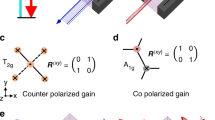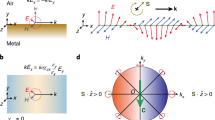Abstract
The Dirac-like dispersion in photonic systems makes it possible to mimic the dispersion of relativistic spin-1/2 particles, which led to the development of the concept of photonic topological insulators. Despite recent demonstrations of various topological photonic phases, the full potential offered by Dirac photonic systems, specifically their ability to emulate the spin degree of freedom—referred to as pseudo-spin—beyond topological boundary modes has remained underexplored. Here we demonstrate that photonic Dirac metasurfaces with smooth one-dimensional trapping gauge potentials serve as effective waveguides with modes carrying pseudo-spin. We show that spatially varying gauge potentials act unevenly on the two pseudo-spins due to their different field distributions, which enables control of guided modes by their spin, a property that is unattainable with conventional optical waveguides. Silicon nanophotonic metasurfaces are used to experimentally confirm the properties of these guided modes and reveal their distinct spin-dependent radiative character; modes of opposite pseudo-spin exhibit disparate radiative lifetimes and couple differently to incident light. The spin-dependent field distributions and radiative lifetimes of their guided modes indicate that photonic Dirac metasurfaces could be used for spin-multiplexing, controlling the characteristics of optical guided modes, and tuning light–matter interactions with photonic pseudo-spins.
This is a preview of subscription content, access via your institution
Access options
Access Nature and 54 other Nature Portfolio journals
Get Nature+, our best-value online-access subscription
$29.99 / 30 days
cancel any time
Subscribe to this journal
Receive 12 print issues and online access
$259.00 per year
only $21.58 per issue
Buy this article
- Purchase on Springer Link
- Instant access to full article PDF
Prices may be subject to local taxes which are calculated during checkout



Similar content being viewed by others
Data availability
The data that support the findings of this study are available from the corresponding author upon reasonable request.
References
Qiao, W. et al. Toward scalable flexible nanomanufacturing for photonic structures and devices. Adv. Mater. 28, 10353–10380 (2016).
Li, C. et al. Dielectric metasurfaces: from wavefront shaping to quantum platforms. Prog. Surf. Sci. 95, 100584 (2020).
Plotnik, Y. et al. Observation of unconventional edge states in ‘photonic graphene’. Nat. Mater. 13, 57–62 (2014).
Bliokh, K. Y. Weak antilocalization of ultrarelativistic fermions. Phys. Lett. A 344, 127–130 (2005).
Morozov, S. V. et al. Strong suppression of weak localization in graphene. Phys. Rev. Lett. 97, 016801 (2006).
Lu, L., Joannopoulos, J. D. & Soljačić, M. Topological photonics. Nat. Photonics 8, 821–829 (2014).
Wang, Z., Chong, Y., Joannopoulos, J. D. & Soljačić, M. Observation of unidirectional backscattering-immune topological electromagnetic states. Nature 461, 772–775 (2009).
Hafezi, M., Demler, E. A., Lukin, M. D. & Taylor, J. M. Robust optical delay lines with topological protection. Nat. Phys. 7, 907–912 (2011).
Cheng, X. et al. Robust reconfigurable electromagnetic pathways within a photonic topological insulator. Nat. Mater. 15, 542–548 (2016).
Khanikaev, A. B. & Shvets, G. Two-dimensional topological photonics. Nat. Photonics 11, 763–773 (2017).
Ozawa, T. et al. Topological photonics. Rev. Mod. Phys. 91, 015006 (2019).
Slobozhanyuk, A. et al. Three-dimensional all-dielectric photonic topological insulator. Nat. Photonics 11, 130–136 (2017).
Yang, Y. et al. Realization of a three-dimensional photonic topological insulator. Nature 565, 622–626 (2019).
Szameit, A., Rechtsman, M. C., Bahat-Treidel, O. & Segev, M. PT-symmetry in honeycomb photonic lattices. Phys. Rev. A 84, 021806R (2011).
Zhen, B. et al. Spawning rings of exceptional points out of Dirac cones. Nature 525, 354–358 (2015).
Leykam, D., Bliokh, K. Y., Huang, C., Chong, Y. D. & Nori, F. Edge modes, degeneracies, and topological numbers in non-Hermitian systems. Phys. Rev. Lett. 118, 040401 (2017).
Liu, T. et al. Second-order topological phases in non-Hermitian systems. Phys. Rev. Lett. 122, 076801 (2019).
Liu, Y. G. N., Jung, P. S., Parto, M., Christodoulides, D. N. & Khajavikhan, M. Gain-induced topological response via tailored long-range interactions. Nat. Phys. 17, 704–709 (2021).
Xia, S. et al. Nonlinear tuning of PT symmetry and non-Hermitian topological states. Science 372, 72–76 (2021).
Parto, M., Liu, Y. G. N., Bahari, B., Khajavikhan, M. & Christodoulides, D. N. Non-Hermitian and topological photonics: optics at an exceptional point. Nanophotonics 10, 403–423 (2020).
Lumer, Y., Plotnik, Y., Rechtsman, M. C. & Segev, M. Self-localized states in photonic topological insulators. Phys. Rev. Lett. 111, 243905 (2013).
Hadad, Y., Khanikaev, A. B. & Alù, A. Self-induced topological transitions and edge states supported by nonlinear staggered potentials. Phys. Rev. B 93, 55112 (2016).
Leykam, D. & Chong, Y. D. Edge solitons in nonlinear-photonic topological insulators. Phys. Rev. Lett. 117, 143901 (2016).
Hadad, Y., Soric, J. C., Khanikaev, A. B. & Alú, A. Self-induced topological protection in nonlinear circuit arrays. Nat. Electron. 1, 178–182 (2018).
D’Aguanno, G. et al. Nonlinear topological transitions over a metasurface. Phys. Rev. B 100, 214310 (2019).
Smirnova, D., Leykam, D., Chong, Y. & Kivshar, Y. Nonlinear topological photonics. Appl. Phys. Rev. 7, 021306 (2020).
Maczewsky, L. J. et al. Nonlinearity-induced photonic topological insulator. Science 370, 701–704 (2020).
Gao, F. et al. Topologically protected refraction of robust kink states in valley photonic crystals. Nat. Phys. 14, 140–144 (2018).
Liu, J. W. et al. Valley photonic crystals. Adv. Phys. X 6, 1905546 (2021).
Haldane, F. D. M. & Raghu, S. Possible realization of directional optical waveguides in photonic crystals with broken time-reversal symmetry. Phys. Rev. Lett. 100, 013904 (2008).
Raghu, S. & Haldane, F. D. M. Analogs of quantum-Hall-effect edge states in photonic crystals. Phys. Rev. A 78, 033834 (2008).
Rechtsman, M. C. et al. Photonic Floquet topological insulators. Nature 496, 196–200 (2013).
Khanikaev, A. B. et al. Photonic topological insulators. Nat. Mater. 12, 233–239 (2013).
Silveirinha, M. G. Bulk-edge correspondence for topological photonic continua. Phys. Rev. B 94, 205105 (2016).
Bisharat, D. J. & Sievenpiper, D. F. Electromagnetic-dual metasurfaces for topological states along a 1D interface. Laser Photonics Rev. 13, 1900126 (2019).
Wu, L. H. & Hu, X. Scheme for achieving a topological photonic crystal by using dielectric material. Phys. Rev. Lett. 114, 223901 (2015).
Barik, S., Miyake, H., Degottardi, W., Waks, E. & Hafezi, M. Two-dimensionally confined topological edge states in photonic crystals. New J. Phys. 18, 113013 (2016).
Barik, S. et al. A topological quantum optics interface. Science 359, 666–668 (2018).
Gorlach, M. A. et al. Far-field probing of leaky topological states in all-dielectric metasurfaces. Nat. Commun. 9, 909 (2018).
Mei, J., Chen, Z. & Wu, Y. Pseudo-time-reversal symmetry and topological edge states in two-dimensional acoustic crystals. Sci. Rep. 6, 32752 (2016).
Smirnova, D. et al. Third-harmonic generation in photonic topological metasurfaces. Phys. Rev. Lett. 123, 103901 (2019).
Tworzydło, J., Groth, C. W. & Beenakker, C. W. J. Finite difference method for transport properties of massless Dirac fermions. Phys. Rev. B 78, 235438 (2008).
Hernández, A. R. & Lewenkopf, C. H. Finite-difference method for transport of two-dimensional massless Dirac fermions in a ribbon geometry. Phys. Rev. B 86, 155439 (2012).
Landau, L. D. and Lifschitz, E. M. Quantum Mechanics: Non-relativistic Theory (Pergamon, 1977).
Parappurath, N., Alpeggiani, F., Kuipers, L. & Verhagen, E. Direct observation of topological edge states in silicon photonic crystals: spin, dispersion, and chiral routing. Sci. Adv. 6, eaaw4137 (2020).
Liu, W. et al. Generation of helical topological exciton–polaritons. Science 370, 600–604 (2020).
Li, M. et al. Experimental observation of topological Z2 exciton–polaritons in transition metal dichalcogenide monolayers. Nat. Commun. 12, 4425 (2021).
Guddala, S. et al. Topological phonon–polariton funneling in midinfrared metasurfaces. Science 374, 225–227 (2021).
Bliokh, K. Y., Dressel, J. & Nori, F. Conservation of the spin and orbital angular momenta in electromagnetism. New J. Phys. 16, 093037 (2014).
Bliokh, K. Y. et al. Spin-to-orbital angular momentum conversion in focusing, scattering, and imaging systems. Opt. Express 19, 26132 (2011).
De Paz, M. B., Vergniory, M. G., Bercioux, D., Garciá-Etxarri, A. & Bradlyn, B. Engineering fragile topology in photonic crystals: topological quantum chemistry of light. Phys. Rev. Res. 1, 032005 (2019).
De Paz, M. B. et al. Energy density as a probe of band representations in photonic crystals. J. Phys. Condens. Matter 34, 314002 (2022).
Xiao, B. et al. Exciting reflectionless unidirectional edge modes in a reciprocal photonic topological insulator medium. Phys. Rev. B 94, 195427 (2016).
Slobozhanyuk, A. et al. Near-field imaging of spin-locked edge states in all-dielectric topological metasurfaces. Appl. Phys. Lett. 114, 031103 (2019).
Li, Y. et al. Mode-selective single-dipole excitation and controlled routing of guided waves in a multi-mode topological waveguide. Appl. Phys. Lett. 120, 221702 (2022).
Shalaev, M. I., Walasik, W., Tsukernik, A., Xu, Y. & Litchinitser, N. M. Robust topologically protected transport in photonic crystals at telecommunication wavelengths. Nat. Nanotechnol. 14, 31–34 (2019).
Collins, M. J., Zhang, F., Bojko, R., Chrostowski, L. & Rechtsman, M. C. Integrated optical Dirac physics via inversion symmetry breaking. Phys. Rev. A 94, 063827 (2016).
Zeng, Y. et al. Electrically pumped topological laser with valley edge modes. Nature 578, 246–250 (2020).
Acknowledgements
The work was supported by the Office of Naval Research (ONR) award N00014-21-1-2092 (A.B.K.), the National Science Foundation (NSF) grant DMR-1809915 (A.B.K.) and the Simons Collaboration on Extreme Wave Phenomena (A.B.K.). D.S. acknowledges support from the Australian Research Council (DE190100430). J.A. and M.A. thank AFRL/RW Emerging Technologies for their support. Fabrication of samples for this work was performed at the Nanofabrication Facility at the Advanced Science Research Center at The Graduate Center of the City University of New York.
Author information
Authors and Affiliations
Contributions
A.B.K. conceived the research. D.S. performed theoretical calculations. S.K. and A.V. performed first-principles simulations, fabrication of samples and optical characterization, including real-space imaging and angle-resolved reflectivity measurements. A.V., S.G. and F.K. assembled the experimental set-up. A.B.K., M.A. and J.A. guided and supervised the project. All authors contributed to discussion of the results and manuscript preparation.
Corresponding author
Ethics declarations
Competing interests
The authors declare no competing interests.
Peer review
Peer review information
Nature Nanotechnology thanks Baile Zhang and the other, anonymous, reviewer(s) for their contribution to the peer review of this work.
Additional information
Publisher’s note Springer Nature remains neutral with regard to jurisdictional claims in published maps and institutional affiliations.
Supplementary information
Supplementary Information
Supplementary text, Figs. 1–4 and references.
Rights and permissions
Springer Nature or its licensor (e.g. a society or other partner) holds exclusive rights to this article under a publishing agreement with the author(s) or other rightsholder(s); author self-archiving of the accepted manuscript version of this article is solely governed by the terms of such publishing agreement and applicable law.
About this article
Cite this article
Kiriushechkina, S., Vakulenko, A., Smirnova, D. et al. Spin-dependent properties of optical modes guided by adiabatic trapping potentials in photonic Dirac metasurfaces. Nat. Nanotechnol. 18, 875–881 (2023). https://doi.org/10.1038/s41565-023-01380-9
Received:
Accepted:
Published:
Issue Date:
DOI: https://doi.org/10.1038/s41565-023-01380-9
This article is cited by
-
Observation of Landau levels and chiral edge states in photonic crystals through pseudomagnetic fields induced by synthetic strain
Nature Photonics (2024)
-
Topological photonics: robustness and beyond
Nature Communications (2024)
-
Detailed analysis of topological edge and corner states in valley-Hall-like photonic Kagome insulators
Applied Physics B (2024)
-
Adiabatic topological photonic interfaces
Nature Communications (2023)



